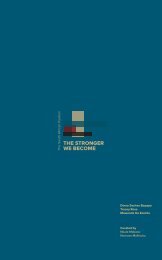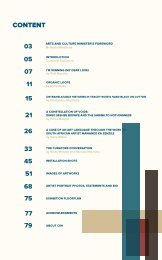The-Stronger-We-Become-Catalogue
Create successful ePaper yourself
Turn your PDF publications into a flip-book with our unique Google optimized e-Paper software.
Enshrined<br />
<strong>The</strong> installation and shrine +/- 1791 (monument to the Haitian Revolution 1791)<br />
(2017) signals Dineo Seshee Bopape’s interest in monumentalisation and<br />
traversing space and time through commemoration. Conceptualised in her<br />
use of the shrine is a connection to Afro-Diasporic spiritual practices and their<br />
relationship with spiritual events that have motivated revolutions. +/- 1791<br />
(monument to the Haitian Revolution 1791), as the title suggests, is a contemplation<br />
on the spiritually-based performances about the Haitian Revolution. Bopape is<br />
drawn to the narrative of Cécile Fatiman, a voodoo priestess who presided over a<br />
ceremony where the Haitian revolution was prophesised. She is fascinated by the<br />
idea of a spiritual gathering conjuring up a political occurrence and the sizeable<br />
effects that spirituality could have on the structure of society. This ceremony<br />
resulted in what would be the first successful anti-slavery revolution. In the<br />
installation, constellations of carefully assembled objects are subliminally placed in,<br />
on and around clay and concrete brick formations. <strong>The</strong> clay bricks are themselves<br />
well-conceptualised objects that sometimes include soil from different regions, cow<br />
dung, and ash. <strong>The</strong>se materials are later compressed and pounded together into<br />
different sized rectangular shapes. <strong>The</strong>re are remnants of healing herbs that are<br />
indigenous to the United Arab Emirates, the site where the work was installed in<br />
2017.<br />
Other objects and materials include cowry shells, soil from Palestine, South Africa<br />
(Marikana) and the Congo, which are all sites of conflict that are marked with the<br />
residue of violence. Scattered around the work are plastic bottles of varying sizes,<br />
some filled with rose water and sea water, the majority filled with fuel and covered<br />
in red and white cloth. <strong>The</strong>se bottles, on initial inspection, resemble petrol bombs<br />
that could be used in acts of conflict or of resistance.<br />
+/- 1791 (monument to the Haitian Revolution 1791) comprises four architectural<br />
structures, and the seemingly unoccupied spaces in between them. It is these<br />
‘unoccupied’ spaces, this void, this nothingness, that is of particular interest to me<br />
and is self-proclaimed by Bopape. Her 2013 video, is I am sky, is a contemplation –<br />
with and through Sun Ra’s An Endless Realm – into the idea of being nothing, or<br />
having nothing, and being in nothing. As such, my contemplation into the idea of (re)<br />
presenting nothingness is rooted in long-standing queries that Bopape has herself<br />
returned to.<br />
I want to speculatively contemplate what it would mean to represent nothingness,<br />
and what shape nothingness, a void, and an absence, would or could take. I am<br />
intrigued by the idea of enshrinement as it relates to presence and non-presence,<br />
being and nothingness. As such, I want to begin with a set of assumptions about<br />
shrines, specifically the idea of commemorating something that used to exist, but is<br />
no longer here or there. While enshrinement is not only for things that have passed,<br />
perished or have died – such as a shrine to an ancestor – this essay presupposes<br />
an enshrinement of things that were there, and are no longer there, things that<br />
existed and now cease to exist. With that in mind, an enshrinement of or to<br />
nothingness assists us in putting pressure on preconceived conceptions that are<br />
rooted in chronological temporality. In other words, what happens when we<br />
consider enshrinement outside of the capture of chronology in the sense of<br />
something existing, undergoing a death, not existing, and then being<br />
commemorated in its absence. What happens when we conceive of enshrinement<br />
as existing outside of time, and outside of place and materiality? What also happens<br />
when we consider an enshrinement to nothingness that is represented by, through<br />
and as nothingness?<br />
I am enchanted by the performance of reading the voids in Bopape’s installations<br />
through Tina Campt’s 1 notion of the low frequencies emitted in the everyday lived<br />
experiences of black people, and the idea that there is merit in paying attention to<br />
the inaudible, seemingly absent frequencies that are at the centre of black life. <strong>The</strong><br />
frequencies that Campt speaks of are the sonic frequencies of black quotidian life.<br />
<strong>The</strong>se are apparently inaudible moments that are not heard through listening, but<br />
rather activate other sensorial responses. It is the “infra-sonic frequencies” that are<br />
not audible to the human ear, but are felt, oftentimes as vibrations². Departing from<br />
Campt, we are compelled to imagine what happens when we listen closely to the<br />
emptiness or empty spaces in and around Bopape’s shrines, and, more specifically,<br />
what happens when we look carefully at nothing. Bopape makes us contemplate<br />
what becomes revealed to us when we stare into nothingness. More significantly,<br />
what happens when we consider the ways in which Bopape has represented that<br />
nothingness and how we engage with that representation?<br />
1 Campt, Listening to Images.<br />
2 Campt, 58<br />
22




